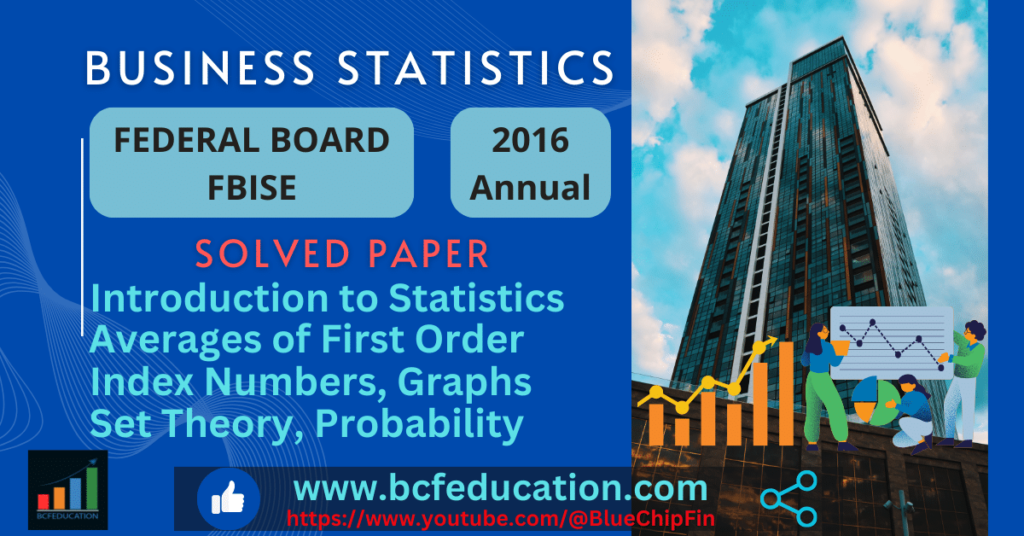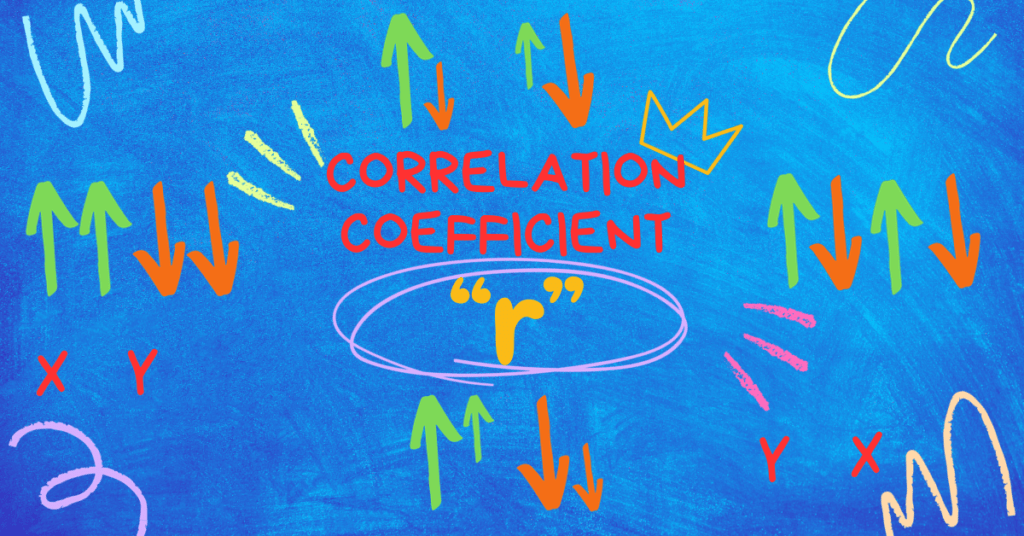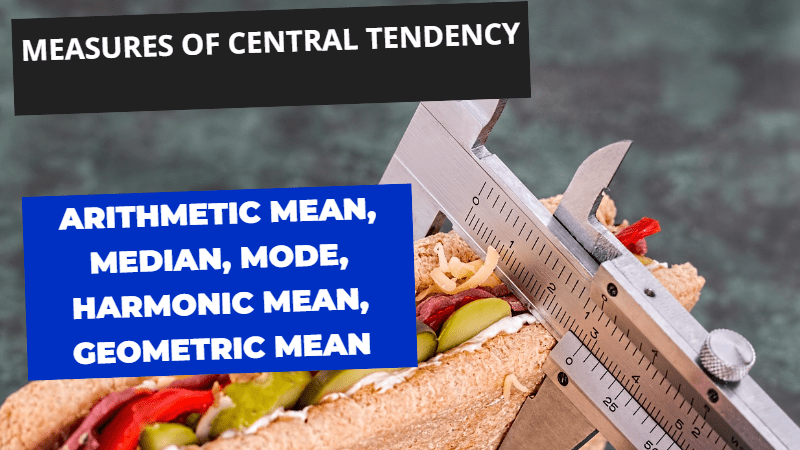Business Statistics Solved Paper FBISE 2016 ICOM II, MCQS, Short Questions, Extensive Questions
In this blog post, I am going to discuss the paper of Business Statistics Solved Paper FBISE 2016 ICOM II, MCQS, Short Questions, Extensive Questions topics included are Introduction to Statistics, Averages, Index Numbers, Probability. Solved paper of Business Statistics Paper 2012 & solved paper of Business Statistics 2013 & Business Statistics 2015 are already published on the website.
Table of Contents
MCQS
| Q.1 Circle the Correct Option i.e. A/B/C/D. Each Part Carries 1 Mark. | |||||
| (i) | Statistics must be: | ||||
| A. Comparable | B. Not Comparable | C. Discrete in nature | D. Qualitative in nature | ||
| (ii) | A measure computed from sample data is called: | ||||
| A. Parameter | B. Statistic | C. Statistics | D. Data | ||
| (iii) | The process of arranging data into rows & columns is called: | ||||
| A. Array | B. Classification | C. Tabulation | D. Frequency Distribution | ||
| (iv) | Graph of frequency distribution is: | ||||
| A. Histogram | B. Ogive | C. Historigram | D. Pie Chart | ||
| (v) | In a symmetrical distribution mean, median & mode are always: | ||||
| A. Negative | B. Different | C. Unequal | D. Equal | ||
| (vi) | D =X – A, means the change of: | ||||
| A. Scale | B. Origin | C. Origin & Scale | D. Units of Measurement | ||
| (vii) | Laspayer’s Index is also called: | ||||
| A. Geometric mean of Paasche’s & Fisher’s Index | B. Ideal Index | C. Current Year Weighted | D. Base Year Weighted | ||
| (viii) | Index for base period is: | ||||
| A. One | B. Fix | C. 100 | D. More than 100 | ||
| (ix) | When a die and coin are rolled together, then the possible outcomes are: | ||||
| A. 6 | B. 2 | C. 12 | D. 36 | ||
| (x) | The probability of sure event is: | ||||
| A.1 | B. 100 | C. 0 | D. 0.5 | ||
Short Questions
Q.2 Attempt any eight parts. The answer to each part should not exceed 3 to 4 lines. (8 x 3 = 24)
(i) What is frequency distribution?
Answer: Frequency distribution is simply the actual occurring of a certain number of a certain number on number between ranges.
(ii) Define population and sample.
Answer Whole group under discussion is called population for example the whole strength of college student or whole population of a certain district etc.
Whereas part of population is called sample for example 30 students out of 100 students or 300 persons out of district population etc.
(iii) What is a pie-chart?
Answer A pie chart (or a circle chart) is a circular statistical graphic which is divided into slices to illustrate numerical proportion. Total area of pie chart is about to 360 degree. Certain variable has multiple proportion can be shown graphically through pie chart.
(iv) If l = 28, fm =25, f1=20, f2=18 and h = 7, compute mode.
Solution
![]()
![]()
![]()
![]()
(v) Distinguish between variable and constant.
Answer A variable is a data, numbers, figures which does not remain fix for example income, consumption, saving etc whereas constant is a number or figure which remain fix for example Avogadro number, gravitational force, mass of earth etc.
(vi) Define mode.
Answer Mode is a type of average. Its symbol is X̂. In ungroup data mode is the most repeated value whereas in grouped data, the formula to calculate mode is given below:
![]()
Where L = lower class boundary, fm = maximum frequency, f1 = frequency above to fm, f2 =frequency below to fm, h= difference of class marks.
(vii) In a certain distribution mean is 45 and mode is 50 then find median.
Solution
Mode = 3 Median – 2 Mean
50 = 3Median – 2(45)
50 = 3Median – 90
3Median = 50 + 90
3Median = 140
Median = 140/3
Median = 46.67
(viii) What is difference between fixed base and chain base method?
Answer In fixed base method, base period remains fixed whereas in chain base method base period does not remain fixed. On the other hand in fixed base method, we calculate price relative whereas in chain base method, we calculate link relative and then we calculate chain index.
![]()
![]()
(ix) Compute index numbers by taking 1957 as base year.
| Year | 1955 | 1956 | 1957 | 1958 | 1959 | 1960 | 1961 |
| Price | 14 | 15 | 16 | 17 | 18 | 19 | 20 |
Solution
| Years | Prices | |
| 1955 | 14 | |
| 1956 | 15 | |
| 1957 | 16 | 100 |
| 1958 | 17 | |
| 1959 | 18 | |
| 1960 | 19 | |
| 1961 | 20 | |
(x) Define mutually exclusive events.
Answer If two events A and B have nothing common between them, then they are called or treated as mutually exclusive events. For example in a toss of coin Head and Tail both are mutually exclusive events because they both cannot occur at same time.
(xi) Solve the following:
(a)
![]()
(b)
![]()
Solution
![]()
![]()
Extensive Questions
Section C (Marks 16)
Note: Attempt any two questions. All questions carry equal marks. (2×8=16)
Q.3 Calculate arithmetic mean by using:
(a) Direct method
(b) Step-deviation method
| Marks | No. of Students |
| 30–39 | 1 |
| 40–49 | 3 |
| 50–59 | 11 |
| 60–69 | 21 |
| 70–79 | 43 |
| 80–89 | 32 |
| 90–99 | 9 |
Solution
| Marks | f | Class Boundaries | X | fX | | fU |
| 30–39 | 1 | 29.5–39.5 | 34.5 | 34.5 | -3 | -3 |
| 40–49 | 3 | 39.5–49.5 | 44.5 | 133.5 | -2 | -6 |
| 50–59 | 11 | 49.5–59.5 | 54.5 | 599.5 | -1 | -11 |
| 60–69 | 21 | 59.5–69.5 | 64.5 | 1354.5 | 0 | 0 |
| 70–79 | 43 | 69.5–79.5 | 74.5 | 3203.5 | 1 | 43 |
| 80–89 | 32 | 79.5–89.5 | 84.5 | 2704 | 2 | 64 |
| 90–99 | 9 | 89.5–99.5 | 94.5 | 850.5 | 3 | 27 |
| Sum | 120 | 8880 | 114 | |||
| ∑f= | ∑fX= | ∑fU= |
![]()
![]()
![]()
![]()
Q.4 Calculate Chain Index numbers for the following data. Use Median as an average.
| Year | A | B | C | D |
| 1958 | 94 | 98 | 82 | 122 |
| 1959 | 98 | 83 | 97 | 105 |
| 1960 | 96 | 87 | 95 | 107 |
| 1961 | 94 | 82 | 97 | 112 |
Solution
![]()
![]()
| Year | A | B | C | D | Median | Chain Index |
| 1958 | 94 | 98 | 82 | 122 | | 88 |
| 1959 | | | | | | |
| 1960 | | | | | | |
| 1961 | | | | | | |
Q.5 From a pack of playing cards, a card is drawn at random, find the probability that the drawn card is:
(i) Ace card (ii) A red card (iii) A king or a queen (iv) A jack of clubs
Solution
![]()
Events
![]()
![]()
![]()
![]()
Probabilities
![]()
![]()
![]()
![]()
You may also interested in the following:
Business Statistics Solved Paper FBISE 2012 ICOM II, MCQS, Short Questions, Extensive Questions
Business Statistics Solved Paper FBISE 2013 ICOM II, MCQS, Short Questions, Extensive Questions
Business Statistics Solved Paper FBISE 2015 ICOM II, MCQS, Short Questions, Extensive Questions
Introduction to Statistics Basic Important Concepts
Measures of Central Tendency, Arithmetic Mean, Median, Mode, Harmonic, Geometric Mean






